How many lakes are there in the National Park?
This may seem like an unnecessary question, especially if you take into account the fact that probably everyone already knows that there are 16 lakes. But is that really so? Anyone who has visited the lake system at least once must have noticed that there are more than 16 lakes, though not all of them have been named, but their total number has not yet been determined.
Based on old cartographic records from the 18th and 19th centuries, it is difficult to determine the exact number of lakes in that period. The maps show much fewer lakes than 16, which is understandable because drawing techniques and cartography were not as developed as they are today.
Different authors from that era also cited different numbers in their publications. So, for example, the Croatian philologist, writer and travel writer Adolfo Weber Tkalčević wrote about his experience of 15 lakes in his travel booklet “Put na Plitvice” (“Trip to Plitvice”) 160 years ago.
Fifteen lakes, many basins, up to thirty larger and smaller waterfalls, four streams, one river, a myriad of hills and ridges with gentle valleys and frightful precipices, prehistoric forests and lush greenery, and above all, drinking water, such as the gods would drink, adorn this perpetuum mobile of the water world, which few people know about even in our homeland, let alone any foreigner.
Adolfo Weber Tkalčević, 1860
Fifty years after him, Prof. Dragutin Franić, in his publication “Plitvička jezera i njihova okolica” (“Plitvice Lakes and Their Surroundings”), describes 16 lakes, but also notes that the names of some lakes as well as the number of lakes are not yet completely established. It is unknown whether the number of lakes really increased by one in this period, or the reason for the difference is that one more lake was named in the meantime.
On the other hand, we must not forget the fact that the tufa formation process, in the course of which tufa barriers are created and grow, made possible the damming of the river valley and the formation of lakes. This dynamic process changes the appearance, but also the number of lakes and cascades. Changes generally occur over a longer period of time, over several hundreds or thousands of years, but they can also be observed even over relatively short time periods, such as a few years or decades. That is why we cannot rule out the possibility that 200 or 300 years ago there were not as many lakes as there are today.
This takes us back to the original question, how many lakes are there really today?
Thanks to technological developments, determining that number is much easier today than it was in the era of the first cartographers or travel writers who wrote about the Plitvice Lakes. To do that, it is no longer necessary to go around each lake on foot, to measure its depth, altitude and surface, although this probably makes the experience incomparably weaker, so since we already have all the necessary technologies, we decided to determine the exact number of lakes.
The calculation was made using orthoimagery of the lake system from 2018. The imaging was done in the early spring of the year, before the budding of the vegetation, so the tufa barriers and the edges of lakes are clearly visible on the images. Each possible lake was marked with a point, and then using DEM (Digital Elevation Model), derived from the LiDAR image of the Park, for each point, i.e. for each possible lake, the altitude was determined. All lakes with an altitude difference of at least 5 cm were then vectorised using polygons and their surface area was calculated. All lakes with a minimum surface area of 10 m2 were included in the total number of lakes. Using this method, we got a total of 90 lakes!

The official number of lakes in the Plitvice Lakes National Park is still 16, with this number encompassing the named lakes; however, the total number obtained is far more important for future monitoring of the dynamics of the lake system. It will be interesting and useful to monitor the changes of this living system over 10, 50 or more years, as well as the increase or decrease of the total number of lakes. Perhaps, over time, two neighbouring lakes will merge into one, as was the case about 400 years ago with Lake Kozjak, or one lake will be divided into two smaller ones due to the rapid growth of the tufa barrier between them. Today, it is impossible to make any assumptions with certainty, but we have all the necessary tools we can use to monitor and record such processes for next generations.



